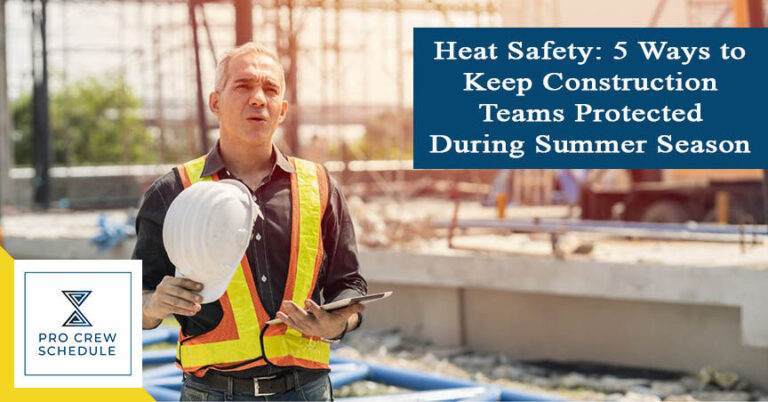The dry season is here, and most construction companies expect an influx of jobs. Unlike winter and rainy seasons, the construction industry is most productive during this season of the year. However, a busy schedule often means that construction teams work in high temperatures, which can have dangerous effects.
Here are five strategies on how you can beat the heat on construction job sites all summer long.
1. Prioritize Hydration on the Jobsite
Hydration is a non-negotiable way to make it through a hot workday on the field without damaging your body. Keeping your team drinking water or electrolytes throughout the day is vital.
The amount of water needed is unique to each person, but a good rule of thumb is to drink eight ounces of any hydrating liquid every 15 to 20 minutes when working on a hot field. This guideline helps ensure your team gets what they need to keep their bodies running efficiently.
Having water and electrolyte drinks like Powerade or Gatorade always ready can help your workers replace the water and nutrients that their bodies lose through sweat. You will go through many of these liquids, so budgeting for them early is important.
While you should encourage your team to bring the hydration liquid of their choice, there is no guarantee that they will always do it. The water bottles they bring might get warm due to sun exposure, reducing some of the liquid’s coolness and making it hard to drink. Keeping enough liquids in coolers will provide everyone access to cold beverages on-site throughout the day. You may also include reminders to hydrate in your work crew scheduling software to ensure they don’t forget it. Doing so will help them stay safe, happy, and healthy.
Educate your workers about why hydrating is essential in general, not only in work settings. During summer, they shouldn’t wait until they feel thirsty to take sips of liquid. Providing open access to on-site restrooms can encourage them to hydrate more since they won’t worry about where they’ll go to relieve themselves. In fact, not going to the restroom at least once every two to three hours on a summer day could be a sign that dehydration is setting in.
2. Know the Signs of Heat Stroke and Heat Stress
Heat stress and heat stroke are among the most common construction job site issues during dry days. Knowing these signs is one of the most crucial ways to help your team as they work long hours in the heat. When left untreated, heat stress can develop into heat stroke, which can be fatal to workers.
The following are typical symptoms of heat stress and are sure signs that the worker needs to cool down and rest.
- Excessive thirst: It’s important to stay hydrated on summer days, but an unquenched thirst could mean the body eliminates the stored water through sweat faster than it can hydrate again.
- Heavy sweating: Sweating is our body’s way of cooling down when our internal temperature increases. While it’s normal to sweat on a construction jobsite, getting drenched in sweat or sweating abnormally couldn’t be a sign of heat exhaustion.
- Nausea: If your body experiences dehydration from heat stress, you’ll feel nauseated — which makes it even harder for your body to take in water or electrolytes.
- Dizziness: Heat stress can also manifest as a rising body temperature or dehydration, which can make you feel like you just got off a carousel, even when sitting or standing.
- Weakness: As your body heat rises, you weaken, making it more difficult to hold things and walk comfortably.
If you notice these symptoms in yourself or another worker, take them to a cool area to cool down, have them sip cold water, and loosen their clothing. Symptoms should begin to improve within an hour. If there is no apparent improvement, get medical help. Incorporate regular health check-ins in your construction crew scheduling to allow them time to observe if they’re experiencing the symptoms of heat stress or heat stroke.
3. Keep Sunscreens on the Construction Jobsite
Any skin exposed to too much ultraviolet radiation can cause sunburn. More than feeling painful or uncomfortable, burns can cause one’s body to retain more heat, boosting the likelihood of heat stress or heat stroke.
Moreover, sunburns have long-term effects, such as increasing the likelihood of skin cancer. The itching and pain from a burn increase an individual’s stress level, which can lead to rapid heart rate and high blood pressure—both conditions amplified by high temperatures.
Aside from the workers’ clothing, applying sunscreen is the best strategy to prevent sunburn. Encourage your workers to bring their own sunscreen if they prefer, but keep some on-site available to use at any time. On average, construction workers should reapply sunscreen every two hours, but it is vital to follow the directions on each sunscreen bottle since specifics may differ.
There are two common types of sunscreen —physical and chemical. Physical sunscreens use minerals that stay on the skin’s surface to repel the intense sun’s rays, while the ingredients in chemical sunscreen sink to the skin to protect against sun damage.
Some workers might opt for physical sunscreen for sensitive skin and more protection. On the other hand, workers might prefer chemical sunscreen if they want a lightweight formula and to avoid a white cast on their skin.
Any sunscreen should have a sun protection factor (SPF) of at least 15 to block more than 90% of the sun’s harmful rays. An SPF 100 sunscreen can block around 99% of UV rays when applied properly for the most sun protection.
4. Provide the Right Equipment for the Season
Part of your job as a manager is to ensure everyone is wearing the right personal protective equipment (PPE) on-site. Your team’s equipment needs vary between seasons, but heat-resistant options are necessary during high temperatures.
Here is what you should consider providing for workers throughout the summer months.
Heat-Protectant Hard Hats
Hard hats of light color keep on-site workers cooler than those in darker colors. This is because light colors absorb less heat than dark colors, decreasing the heat that warms one’s head and body in general.
A wide brim can shade your workers’ faces, protecting them from harmful UV rays and lowering the temperature in the topmost area of their body. If there are no electrical hazards on the job site, consider providing hard hats with air vents that allow for more airflow.
Eye Protection
Sunglasses are helpful when doing various activities in the sun, but workers often need something stronger than typical sunglasses on a construction site. However, normal safety goggles might be unable to deflect the sun’s glare, making it harder for workers to see what they’re doing and endangering them.
Safety sunglasses are the perfect combination of UV-protective, anti-glare sunglasses with strong lenses and a secure fit of safety goggles.
Hand Protection
You want each team member to have heat-resistant, lightweight work gloves. Often made with silicon or terry cloth, these gloves can protect against sunburns when working with or around heat-absorbing materials and other hot surfaces.
High temperatures can cause worker’s hands to sweat more easily, making it more difficult to grip tools and equipment. Silicone grips can make a big difference when handling construction items. If workers are more than six feet off the ground, they should be secured with a proper fall arrest system to keep them safe if they slip while working.
The right PPE and proper tools and equipment will ensure the safest environment possible for your workers in any season. In your construction inventory management software, take a comprehensive inventory of your available PPEs to ensure you are ready for hot work days.
5. Loosen Up Your Break Policy
While construction deadlines can be tight, it’s necessary to prioritize your team’s safety and health. Summer is a good time to loosen up your break schedules, allowing workers to use sunscreen, cool down, rest, and hydrate off the site. These actions keep their bodies regulated and able to work in the hot season, and each worker knows their body best.
Some workers might require more cooling breaks than others, and there is no shame in that. It takes time to adapt to working in the heat. Around 50%-70% of heat-related deaths on job sites happen in the first days due to a lack of acclimation and just focusing on getting the job done. Hence, ensure that a few days of adaptation to heat is incorporated into the construction crew scheduling during summer days.
If no awnings or shady trees are nearby, set up shelters around the job site for everyone to enjoy shade on their breaks. These spots will protect their eyes and skin from the sun while allowing them to cool down their body temperature.
Key Takeaway
Your business can’t survive without your construction team, which puts their hard work into each project you assign to them. As a leader, taking steps to keep them safe during long summer days is necessary.
Add summer precaution reminders in your construction manpower scheduling software, like the Pro Crew Schedule, to ensure no one gets dehydrated during this season. These five tips will help each team member stay healthy and happy.







